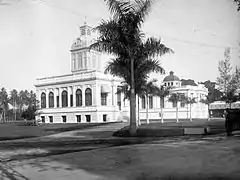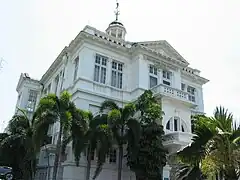Bank of Java
The Bank of Java (DJB, for De Javasche Bank) was a note-issuing bank in the Dutch East Indies, founded in 1828, and nationalized in 1951 by the government of Indonesia to become the newly independent country’s central bank, later renamed Bank Indonesia. For more than a century, the Bank of Java was the central institution of the Dutch East Indies’ financial system, alongside the “big three” commercial banks (the Netherlands Trading Society, the Nederlandsch-Indische Handelsbank, and the Nederlandsch-Indische Escompto Maatschappij).[1]: 703 It was both a note-issuing bank and a commercial bank.

Background
The first bank founded in the Indonesian archipelago was the Bank van Courant, established in 1746, to support trading activity. In 1752, it was renamed De Bank van Courant en Bank Van Leening (lit. 'Bank of current [accounts] and loans'), and was given a mandate to extend loans to employees of the Dutch East India Company. In 1818, that institution closed as a consequence of financial crisis.[2]
Dutch colonial period
King William I of the Netherlands granted the right to create a private bank in the Indies in 1826, which was named De Javasche Bank. It was founded on 24 January 1828, and later became the bank of issue of the Dutch East Indies, issuing and regulating the Netherlands Indies gulden.
In 1829, it opened branch offices in Semarang and Surabaya. Later branch offices opened in Padang (1864), Makassar (1864), Cirebon (1866), Solo (1867), Pasuruan (1867), Yogyakarta (1879), Pontianak (1906), Bengkalis (1907), Medan (1907), Banjarmasin (1907), Tanjungbalai (1908), Tanjungpura (1908), Bandung (1909), Palembang (1909), Manado (1910), Malang (1916), Kutaraja / Banda Aceh (1918), Kediri (1923), Pematang Siantar (1923), and Madiun (1928).[2]
Until 1891, the DJB was represented in the mainland Netherlands by the Netherlands Trading Society. That year, it opened an office in Amsterdam, which in 1922 was converted into a subsidiary known as Bijbank Javasche Bank or Javasche Bank Nederland.[3] Some time later, DJB opened an office in New York.[4]
Under the Japanese occupation of the Dutch East Indies during World War II, the occupation authorities closed the Bank of Java and all other Dutch and Western banks in March 1942, and endeavored to seize as much as possible of their assets.[1]: 706 They replaced it with an ad hoc central bank for occupied Indonesia, named Nanpo Kaihatsu Ginko (Japanese: 南方開発金庫, lit. 'Southern Development Bank'). The Bank of Java could only reopen after the surrender of Japan in the late summer of 1945.
Nationalization and aftermath
The Bank of Java was nationalized by the Sukarno government in 1951, and renamed Bank Nasional Indonesia on 1 July 1953. By that time, Europeans still represented four-fifths of the Bank's employees.[5]
In 1962, Bank Indonesia moved to a new head office building. Its former main building on Station Square in Jakarta was left to deteriorate. It was renovated in the 2000s, and repurposed as Bank Indonesia Museum, which opened on 21 July 2009.
In 1966, the bank's affiliate in Amsterdam became the Indonesian Overseas Bank, later renamed Indover Bank. It was eventually liquidated in 2008.[3]
Leadership
Presidents of the Bank of Java have included:
- Chr. de Haan (1828–1838)
- C.J. Smulders (1838–1851)
- Emanuel Francis (1851–1863)
- Carel Wiggers van Kerchem (1863–1868)
- J.W.C. Diepenheim (1868–1870)
- Fokko Alting Mees (1870–1873)
- Norbertus van den Berg (1873–1889)
- Sako Zeverijn (1889–1893)
- D. Groeneveld (1893–1898)
- J. Reijsenbach (1899–1906)
- Gerard Vissering (1906–1912)
- Ede Zeilinga (1912–1924)
- Leonardus Trip (1924–1929)
- Gerard van Buttingha Wichers (1929–1945)
- J.C. van Waveren (1946)
- R.E. Smits (1946–1949)
- A. Houwink (1949–1951)
- Sjafruddin Prawiranegara (1951–1953)
Buildings
The main building of the Bank of Java in Batavia was erected in 1909, on a design by Eduard Cuypers and Marius Jan Hulswit, on the location of the former city hospital. The building was comprehensively remodeled in 1926, was a new façade on Station Square.[4] The head offices of the three large banks were built on adjacent lots in the 1920s and 1930s, namely the Nederlandsch-Indische Escompto Maatschappij to the north, the Netherlands Trading Society to the south, and the Nederlandsch-Indische Handelsbank to the northeast.
The Amsterdam office was opened in 1891, at 60 Reguliersdwarsstraat, in a suite of offices hosted by the Hollandsche Hypotheekbank. It moved to Keizersgracht 668 in April 1892. In 1920, DJB expanded to the nearby building at Keizersgracht 664, and in 1937–1939, the bank erected a new office building on numbers 664-666, designed in 1936 by the architecture firm of Christiaan Posthumus Meyjes jr. and Jakob van der Linden. The successor entity, Indover Bank, remained there until 1992, when it moved to Stadhouderskade.[3]
 Head office in Batavia, before remodeling in 1926
Head office in Batavia, before remodeling in 1926 Interior hall (2016)
Interior hall (2016) Inner court (2018)
Inner court (2018) Stained glass window (2018)
Stained glass window (2018).jpg.webp) Keizersgracht 666-668, former office of the Bank of Java in Amsterdam
Keizersgracht 666-668, former office of the Bank of Java in Amsterdam Branch office in Bandung, built in 1918; now a museum
Branch office in Bandung, built in 1918; now a museum Branch office in Medan
Branch office in Medan The same building, now Town Hall and Bank Indonesia branch
The same building, now Town Hall and Bank Indonesia branch Branch office in Surakarta
Branch office in Surakarta Branch office in Yogyakarta
Branch office in Yogyakarta Branch office in Padang
Branch office in Padang Branch office in Palembang (1950s)
Branch office in Palembang (1950s) Branch office in Surabaya
Branch office in Surabaya Branch office in Malang
Branch office in Malang Branch office in Banda Aceh
Branch office in Banda Aceh
Banknotes
_-_Baldwin's_Hong_Kong_Coin_Auction_(2012).jpg.webp) 25 Guilders, 1920
25 Guilders, 1920 10 Guilders, 1934
10 Guilders, 1934 5 Guilders, 1935
5 Guilders, 1935 5 Guilders, 1937
5 Guilders, 1937 50 Guilders, 1938
50 Guilders, 1938
See also
Notes
- Shibata Yoshimasa (1996), "The monetary policy in the Netherlands East Indies under the Japanese administration", Bijdragen tot de Taal-, Land- en Volkenkunde, Brill, 152:4 (4): 699–724, JSTOR 27864801
- "History of Bank Indonesia". Bank Indonesia.
- "Indover Bank". Amsterdams Grachten Huizen.
- Dirk Teeuwen. "Javasche Bank, the Old Dutch City Hospital of Batavia-Jakarta and the Mandiri Bank Museum" (PDF). Indonesia, Dutch Colonial Heritage.
- J. Thomas Lindblad (2004), "Van Javasche Bank naar Bank Indonesia : Voorbeeld uit de praktijk van indonesianisasi", T.SEG/ Low Countries Journal of Social and Economic History, 1:1: 28–46, doi:10.18352/tseg.791